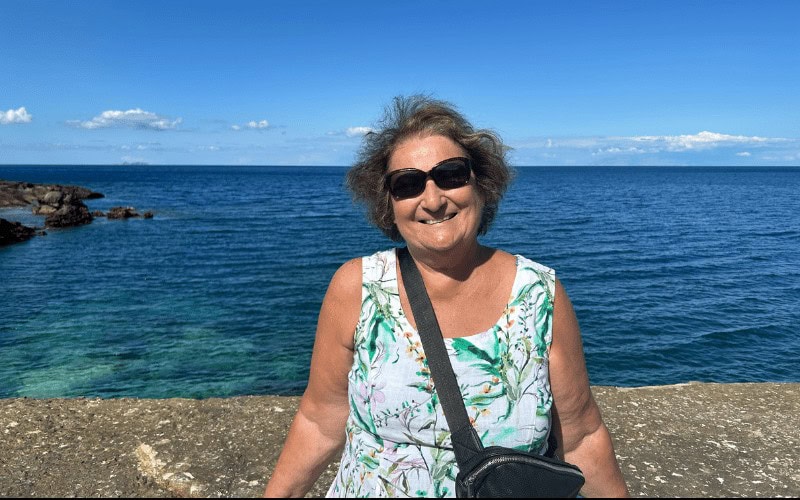How to Spend Two Laid-Back, Glorious Days on the Greek Island of Naxos
Artsy Traveler contains affiliate links for products and services I personally use and can happily recommend. As an Amazon Associate, I earn from qualifying purchases. Please read the Disclosure for more information. If you make a purchase through these links, at no additional cost to you, Artsy Traveler earns a small commission. Thank you!
Are you planning a trip to Naxos and you’re not sure what to do?
Spending two or three days on the beautiful Greek island of Naxos gives you a taste of this lovely island and definitely leaves you wanting more!
I visited Naxos after spending four days on uber-touristy Santorini, and it was a relaxing revelation. Naxos feels like a Greek island where Greek people actually live.
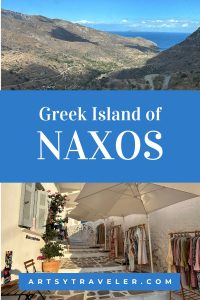
Plenty of visitors bask on the beaches and eat in the many harborside restaurants, but the place doesn’t feel inundated. Part of the appeal of Naxos is that cruise ships do not come here. Let’s hope that doesn’t change!
During the evening, stroll along the waterfront and through the labyrinthine lanes of the old town (called, fittingly, the labyrinth), mingle with the locals, and watch the children play in the largely car-free streets. Everyone seems to be in a good mood.
And why not? The air on a September evening is warm but not stifling, the sunset over the Aegean is magnificent, the food well prepared (and cheaper than Santorini), and the general atmosphere easy going.
In this 3-night and 2 full-day Naxos itinerary, I cover what you need to know about planning a short trip to Naxos: including where to stay, how to get around, and what to do.
I suggest you spent one day relaxing on one of the many gorgeous beaches in Naxos and one day touring the island, either on an organized tour or on your own in a rental car.
Map of Naxos: Locations Visited
Naxos is the largest island in the Cyclades and a popular destination. The map of Naxos below shows the locations I visited.
I stayed at Giorgios Beach (#1), a short walk from the main town of Chora (#2) and the ferry dock. Click a number to read more about each location.
How to Get to Naxos
Since Naxos is an island, you have only two choices for how you get there (unless you have your own boat or are a very strong swimmer).
While most people take the ferry from Athens or another island, you can also fly to Naxos.
If you’re island hopping, you’ll probably take the ferry. On my trip to the Greek islands, I flew from London to Santorini and then took the ferry from there to Naxos and then from Naxos to Athens.
Following is my experience of the ferry trip to Naxos.
My Experience: Leaving Santorini
We bid farewell to Aethrio Sunset Village and take a taxi to the ferry port. Unlike the old port that services the cruise ships, the ferry port is accessible by car and bus down a very steep series of switchbacks.
When our ferry arrives, we join the throngs of suitcase-toting visitors for the mad dash up the gangplank and into the cavernous hold.
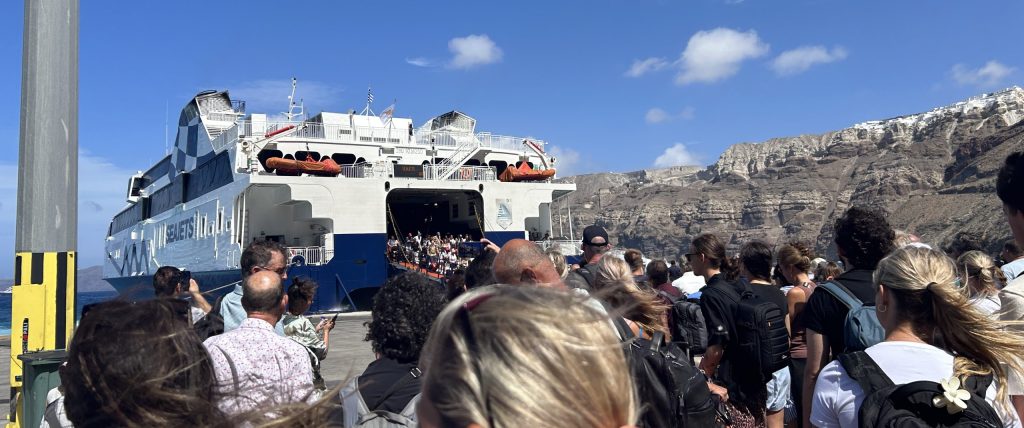
The loading and unloading of a Greek ferry is the very definition of organized chaos.
The ferry workers blow whistles and gesture for us to form two orderly lines (fat chance). It doesn’t seem possible that all the people waiting with us on the dock will fit on the boat. But within a surprisingly short time, we’re all aboard.
Before we’ve even found the place to stash our luggage, the gangplank comes up and the voyage is underway.
It’s a windy day and the ferry is rocking, but we manage to locate the luggage area marked “Naxos” and leave our luggage before mounting the stairs to the passenger lounge.
We used Ferry Hopper to book our two ferry trips in the Greek Islands—Santorini to Naxos and Naxos to Athens. The online ticketing went smoothly, and the app was easy to use. When we boarded the ferry, we showed the tickets on the app to the attendant who scanned them and waved us through.
Traveling to Naxos
To get to Naxos from Santorini takes about 90 minutes. My daughter Julia knocks herself out with a piece of Gravol gum and I settle in to write while occasionally glancing out at the white-capped sea.
The ferry docks briefly at the island of Ios and then Naxos is next. As soon as we hear the island announced, we leap out of our seats and clatter down the stairs to the hold.
At Ios, I saw how little time is allowed for loading and unloading and I’m terrified of being left behind!
Arrival on Naxos – Stay at Kalergis Studios
We are among the first visitors off the ferry, where we find the taxi rank and are soon on our way to Kalergis Studios on Plaka Giorgios.
For our three night stay in Naxos, the small studio is perfect. It contains two beds, a tiny kitchen, a bathroom, and a balcony overlooking one of the most famous beaches in Naxos.
The reasonably-priced place (three nights cost the same as one night in Oia!) is located right on the beach and just a ten-minute stroll to Chora.
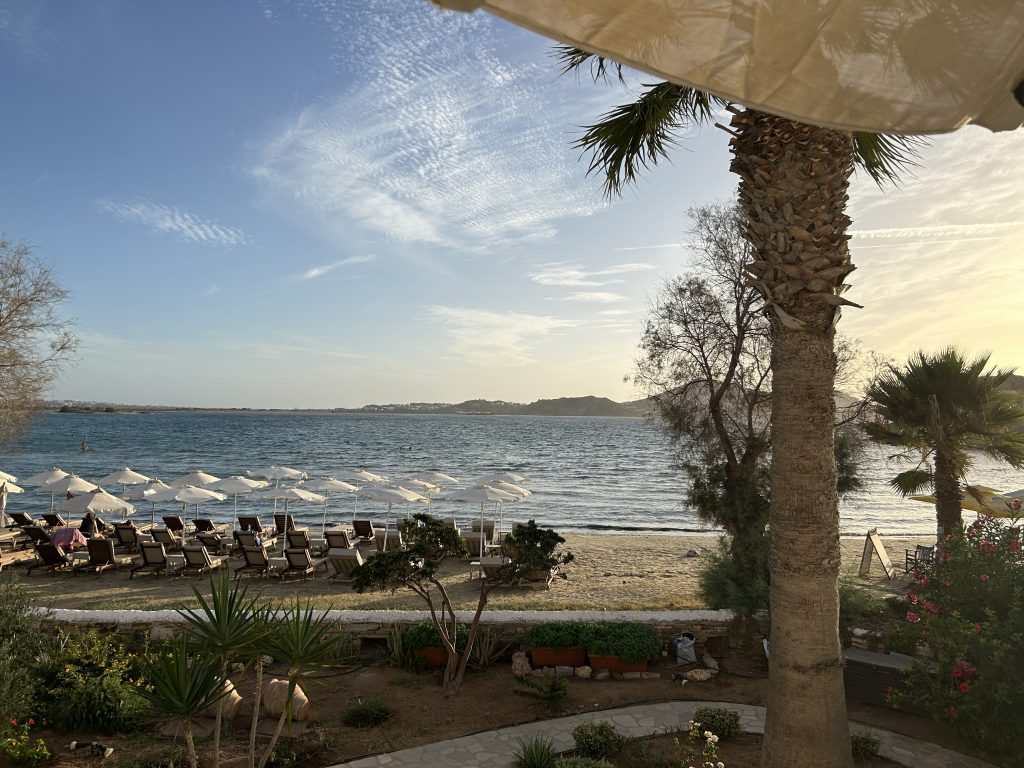
Our first order of business is to enjoy a late lunch at Yannis, the beachside café adjacent to Kalergis Studios that also manages a fleet of sunbeds. The portions are enormous!
Here is the most massive hamburger Julia has ever eaten and my traditional Greek Dakos salad., a delectable combination of super fresh tomatoes, olives, onions, feta cheese and crunchy dried bread. It’s also so large that I enjoy the rest of it for lunch the next day.


Although groaningly full after our lunches, we have to jump into the Aegean Sea. Apart from our bobbing swim in the hot springs cove on the boat trip on Santorini, we’ve not yet swum from a proper Greek beach.
Agios Georgios Beach (#1 on the map above) is sandy, and the water is just the right temperature to be refreshing. It’s also very shallow, requiring a long wade out before the water’s deep enough to dive into.
We bob happily for a while before returning to our room and getting ready to check out the Naxos sunset.
Sunset on Naxos
Sunsets really are a thing in Greece! On Naxos, the most popular place from which to watch the sunset is the Portera (#2) near the old town.
Also known as the Temple of Apollo, the Portera is a huge marble gate and all that remains of the temple of Apollo that was built, but never finished, in 530 BC.
We stroll toward the Portera, but my knee is aching, so I opt to sit on a bench overlooking the boats bobbing in the harbor while Julia runs on ahead to catch the sunset from the Portera.
Here are two of her amazing shots.


The Naxos sunset just keeps on giving. Long after the sun sets, the sky continues to change in one of the most dramatic displays I’ve seen in a while.



After finally tearing our eyes from the sky, we settle on dinner at one of the many places lining the harbor in Chora, the main town on the island.
Enjoying this post? Subscribe to Artsy Traveler to Receive Valuable Travel Tips and Your FREE Guide: 25 Must-Do Artsy Traveler Experiences in Europe for 2025

The Greek food is hearty and tasty, and the ambiance can’t be beat.
Day 1 on Naxos – Relax!
On our first of two full days in Naxos, we decide to enjoy a beach day—our only one of the entire 16-day visit to Greece.
If you have the time and you love beaches, stay longer in Naxos and explore some of its many gorgeous beaches. See the map at the end of this post with suggested options.
After breakfast, we walk only about ten feet from the café below our window to our sun loungers for the day. At a cost of 25 euros, the loungers are a bargain compared to what I’ve paid in France.
And with a breakfast like this to start the day, how can we go wrong?

We seriously do nothing for the entire day. The air is breezy and warm, the sun hot but not unbearable, the view of the sparkling blue Aegean sea restful, and the occasional swim restorative.
It’s the perfect way to relax!
And then before we know it, the sun is starting to set again and it’s time to think about an evening walk and dinner.
Schedule at least one down day during your trip. Even the most avid sightseer needs time to recharge and restore. And what better place to do it than on a balmy beach in Naxos!
Exploring Chora
Thoroughly sun-warmed and relaxed, we follow the sunset back to Chora and stroll up to the top of the town to see the view.
The town’s narrow lanes, colorful door frames and prowling cats charm at every turn. We are virtually alone as we wander around, occasionally checking out a souvenir store or snapping a picture of one of the cats.
Cycladic Village Architecture
We learn later when we go to Athens that the tight architecture of the villages in the Cyclades Islands owes a lot to pirates. Over the millennia, pirates (the so-called Sea People) have been a constant thorn in the side of peaceful occupants of islands such as Naxos.
To protect themselves, people built their villages with houses very close together and clustered around narrow, serpentine lanes that wind around and through the villages with seemingly no logic. If a pirate manages to get to such a village, they can be more easily repelled.
At least that’s what our tour guide in Athens tells us a few days later and who am I to contradict?
The result of all this pirate repelling are villages that to our modern eyes are irresistibly charming and achingly picturesque. Every turn brings into focus another angle for another photo.
Cobbled lanes and slippery steps lead up, up, up to the Venetian castle of Naxos between houses so close they can be touched with outstretched hands.



Cats in Chora
And everywhere there are cats—lounging across the tops of thick walls, tails swishing lazily in the heat, stalking around corners, skittering across the cobblestones. At one corner in Naxos’s old town of Chora, we count eleven cats in various attitudes of total relaxation.
Cats are a thing in Greece, we are discovering. They are everywhere! Most look sleek and well fed, although I think they are feral.
Their presence is a constant source of pleasure for photo-snapping tourists, us included.
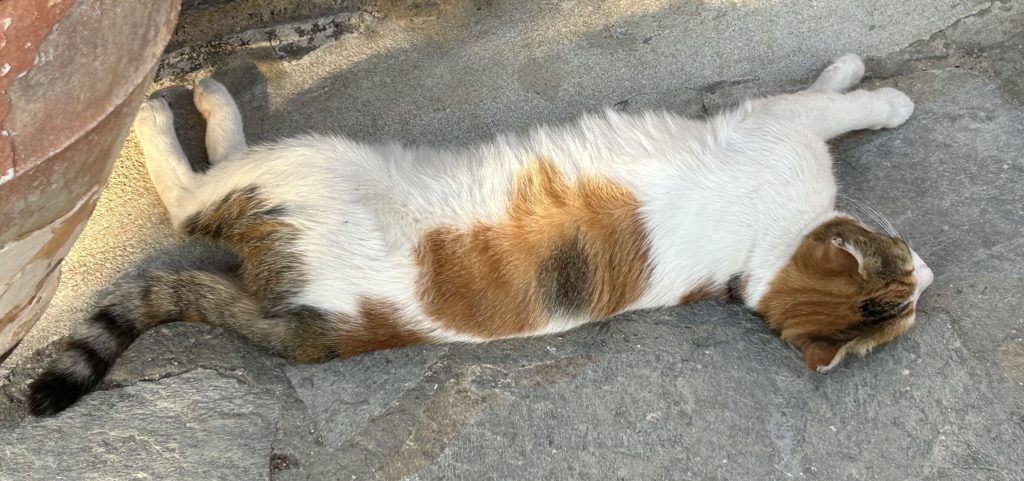
Dinner in Chora
After our wandering and picture-snapping, we go in search of a well-reviewed restaurant in the labyrinth.
Google’s restaurant reviews have not failed us yet. With its 4.8 rating, Restaurant Doukato looks like a good bet—and it is.
After being seated under a huge tree in an airy courtyard, we order chicken souvlaki for two. While we wait, we watch in awe as the black-clad waiters literally run from table to table.
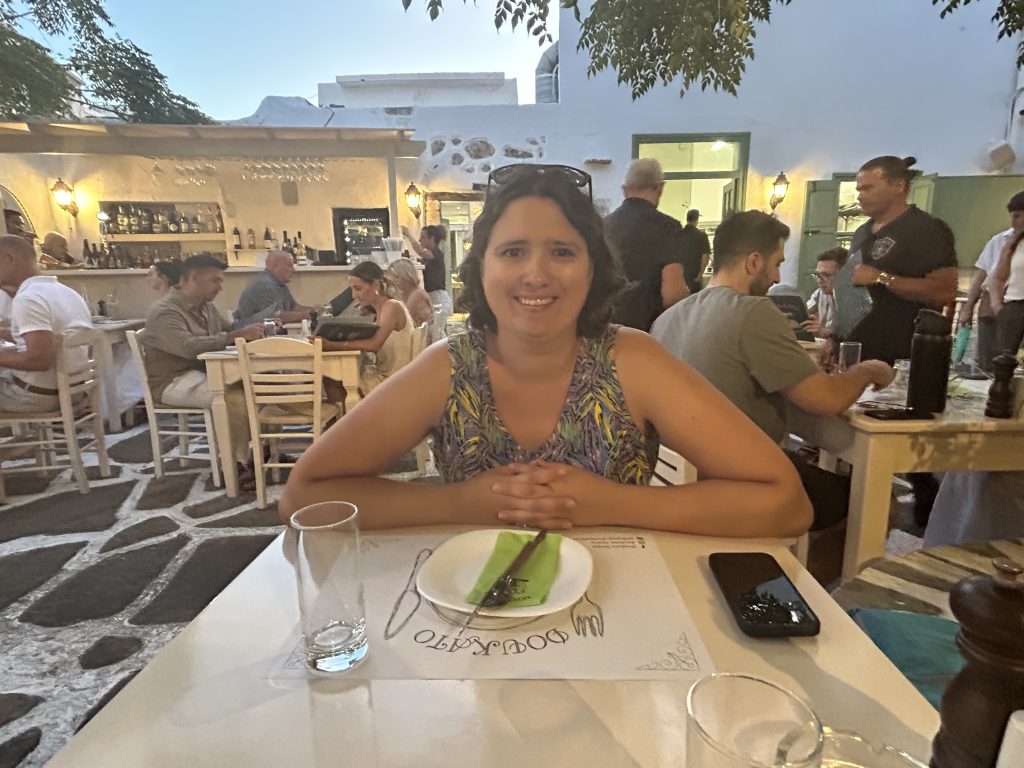
I’ve never seen servers work so hard! One young man actually sprints, while holding aloft plates of food. When our souvlaki comes, he plunks it down and rushes off, only to return seconds later to offer to help us de-skewer the chicken.
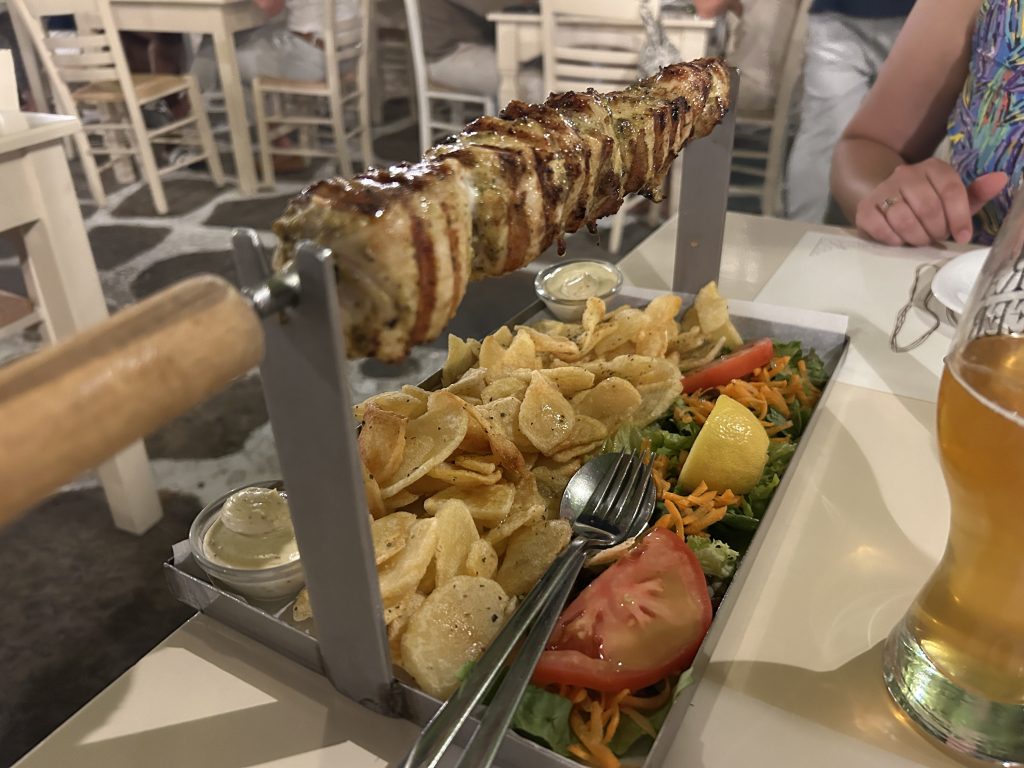
The meal is plentiful and tasty. We take home what we can’t eat (the portions are HUGE in Greece) and enjoy it for dinner the next night after our tour of Naxos.
Day 2 on Naxos – Tour the Island
On our second of two full days on Naxos, we’ve booked an all-day tour that will take us inland to exlore some of the villages of Naxos.
If you don’t have a rental car, then I highly recommend taking a tour, preferably a small group one or even a private tour. But if your budget is limited or you can’t find a suitable tour, taking a big bus tour at least gives you a taste of this spectacular island.
We end up on a big bus tour, which is not our preference, but we couldn’t find a small group tour on the day we are in Naxos.
The plus is that the price is startlingly reasonable—just 30 Euros each for an eight-hour guided tour that takes us all over this big island. Here are a few tours to consider.
Starting on the Tour
As two of the last people to be picked up, we settle into our seats in the second to last row and prepare to enjoy ourselves. Unfortunately, my ability to hear the guide’s commentary (and I do love a good commentary) is marred by the incessant chattering of the two women behind me.
I don’t want to be that person by asking them to be quiet, but all my attempts at subtle body language cues such as glancing back, cupping my hand around my ear, leaning forward and so on fail to produce the desired quietude.
And since they are speaking French, I can’t even eavesdrop.
Other than putting up with their rudeness (and to add insult to injury, they are fellow Canadians!), the tour is an admittedly efficient way to see the highlights of Naxos with minimal effort.
What to See on Naxos
On our 8-hour bus tour, we explore several villages on the island along with other must-see sites. If you have your own wheels, you can see these sites over more than one day and take your time.
But I found that a bus tour, while “touristy” was worthwhile, and gave me a good overview of the island’s fascinating history dating back millenia. Here are the places we visited, with details about each following:
- Demeter’s Temple
- Damalas
- Chalki
- Apiranthos
- Apollonas
- Colossus of Dionysius
Demeter’s Temple
We leave the town of Chora and head up into the hills. Right away, we see that Naxos is very different from Santorini.
As the largest of the Cyclades Islands, Naxos’s ecosystem is very different from desert-like Santorini. Although dry, the landscape is much more verdant with plenty of greenery and high mountains framing views of the ever-blue Aegean.
There is a great deal of agriculture here, including olive oil production, which explains the delectable freshness of the food. We’re told that Naxos grows most of the food consumed on the island.
It’s no wonder the tomatoes taste like they’ve just been twisted from the vine because they probably have.
Our first stop is the temple of Demeter (#3) which we’re told dates from 530 BC. Over the centuries, the temple suffered attacks and repurposing, including the building of a small Christian basilica in its center.
As is the case throughout Greece, the marble and other materials from ancient temples were frequently used to build Christian churches. I learn that the impressive looking ruins were rebuilt in 1977.
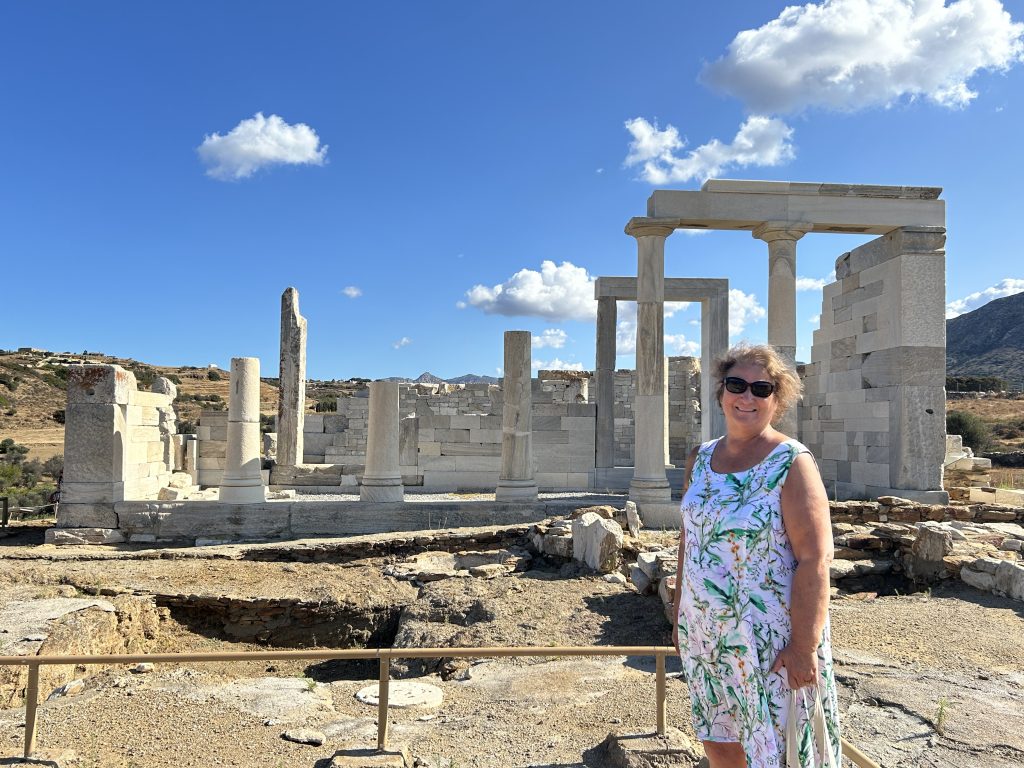
The Temple of Demeter doesn’t take long to explore and includes a small museum that we pop into.
If you go, try timing your visit for first thing in the morning or later in the afternoon when the tour buses are all gone. You’ll have the evocative ruins all to yourself.
Pottery Workshop in Damalas
We stop in the village of Damalas (#4) to watch a pottery demonstration. The potter throws a pot with impressive speed and accuracy.
I’ve dabbled in pottery a bit and recognize expertise when I see it. His pot comes out perfectly.
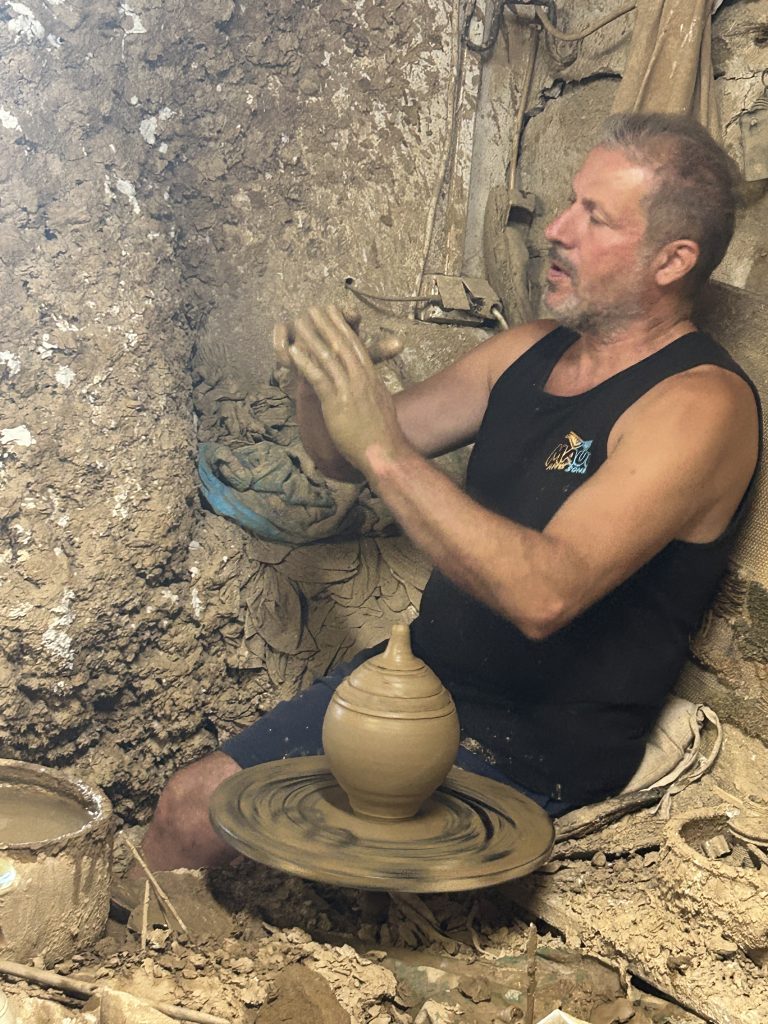
The small store adjacent to the workshop sells an impressive array of plates, jugs, platters, and figurines. I purchase a bowl and resolve that it will be my one pottery purchase of the trip.
I have a soft spot for buying pottery while traveling, but I have only a carry-on this trip and must make hard choices.
Chalki
The tour progresses at a brisk rate with frequent stops, the next being the charming village of Chalki (#5) where we have forty minutes to wander the picturesque alleys and sample olive oil and citron liqueur.
I buy a can of olive oil and a small bottle of the liqueur because, well, why not?
The town also contains an ancient Byzantine church called Panagia Drosiani that dates from the 4th to 6th centuries AD. We tale a quick look inside; the frescoes are impressive.
Apiranthos
The village of Apiranthos (#6) is billed as the most famous village in Naxos because of its marble cobbled streets (slippery when wet), narrow lanes, and panoramic views.
It is definitely charming, and we enjoy a stroll around.
A strip of cafés cater to the tour bus people, but we do our best to escape and walk up into the village in the short time allocated.
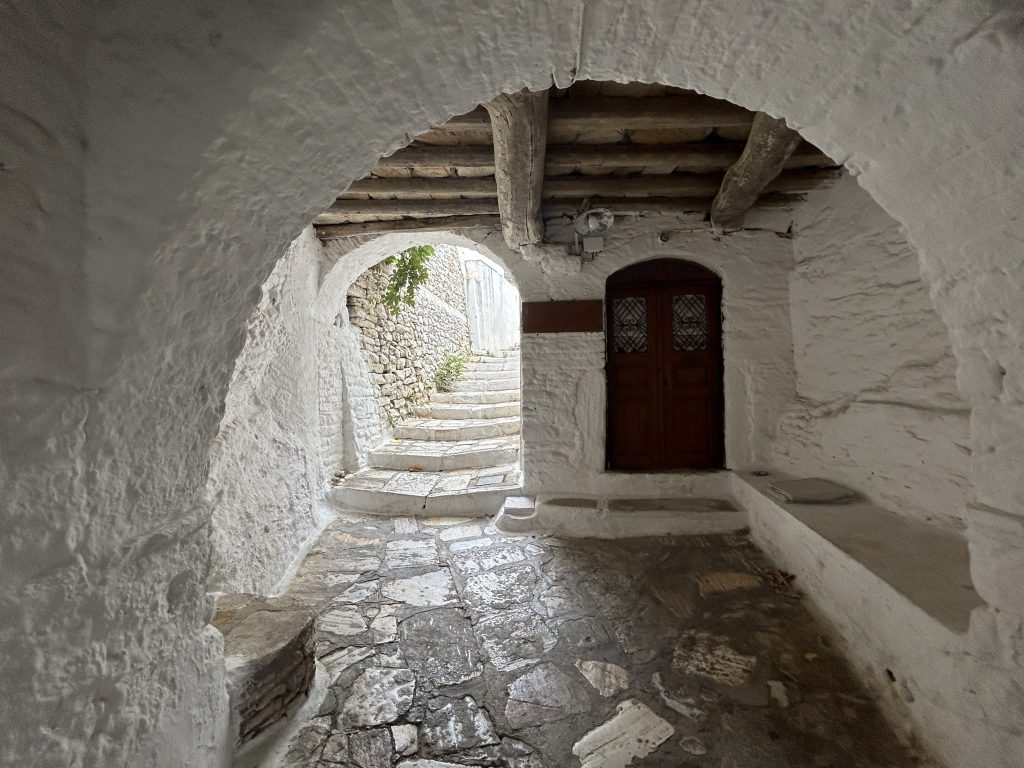
Apollonas
Between Apiranthos and the seaside village of Apollonas (#7) lies some seriously twisty-wisty mountain roads. Our driver takes us around sharp curves and up steep slopes that would be challenging to negotiate in a small car, never mind a bus the size of a whale on wheels.
I’m very, very glad I decided not to rent a car on Naxos. If you really don’t like tours, then a car is your only option, but make sure you have nerves of steel!
The views are stunning in this remote area of the island. Our guide tells us about some of the tiny villages we lumber through. Historically, life was very harsh and populations are decreasing.
Finally, we reach the seaside and our final major stop of the day.
It’s almost 3 pm and well past time for lunch. The village of Apollonas clusters alongside a white sand beach. Several inviting cafés await the influx of the tour buses.
We find a table right at the edge of the water and order the best lunch of our entire trip (which is saying something).
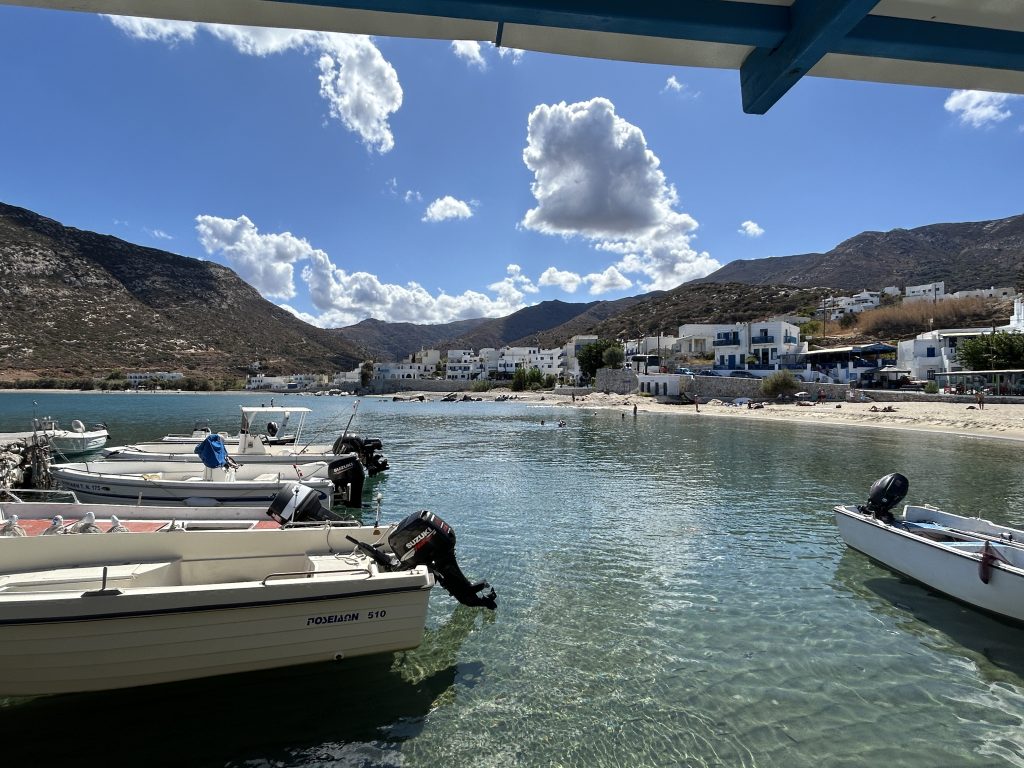
Tzatziki is one of our favorite Greek dips and we eat it several times, but nothing tops the flavor, texture, and garlic content of the tzatziki at the little café in Apollonas.
We devour it along with a massive Greek salad and an order of saganaki (Greek fried cheese).
Kourus Statue – AKA the Colossus of Dionysius
Our last short stop is to admire a prone, large, and unfinished marble statue that is over 10 meters in height, weighs 80 tonnes, and dates to the 8th century BC.
Because the statue wears a long cloak and has long hair and a beard, most researchers think it depicts Dionysius, but some disagree and favor Apollo. I don’t suppose they’ll ever know for sure.
Verdict on the Big Bus Tour
Taking the bus tour did at least allow us to see a lot of Naxos. If it’s your only option, then definitely take a big bus tour rather than miss out on seeing the stunning Naxos countryside.
But if possible, opt for a small group tour or a private tour. Yes, you’ll pay more, but you’ll also avoid long waits getting on and off the bus and chatty people who talk over the commentary.
You’ll also likely go on smaller roads that the big buses can’t access, and you won’t feel quite so much like a tourist!
Last Night in Chora
We arrive back in Chora (AKA Naxos town) around 5 pm and return to Kalergis Suites for one last swim in the Aegean before the sun sets.
For dinner, we eat leftovers from our souvlaki dinner the night before. It tastes even better the second night—and the price can’t be beat!
In the evening, we stroll the fifteen minutes back to Chora to poke through the many souvenir stores and enjoy the relaxed ambience, very different from bustling Santorini.
I will definitely return to Naxos for a longer stay.
Leaving Naxos
Bright and early, we bid farewell to Kalergis Suites and take a taxi back to the port. More or less on time, the ferry churns in.
Along with 500 of our new friends, we surge up the gangway and stash our luggage. Before we’re halfway up the stairs to the passenger lounge, the ferry is pulling away from the port and we’re off.
The Joys of Upgrading
We find and settle into two very tight seats with no view and no leg room in tourist class. The voyage takes almost four hours, and Julia decides to check on upgrading to business class.
Off she goes to inquire, returning ten minutes later with upgraded tickets (25 euros each). We mount the interior staircase to business class where we discover that the extra cost is well worth the increased comfort of much wider seats and a view of the passing sea.
I’m all for saving money, but more and more, I opt for comfort over budget whenever I can.
With more room, I’m able to work on my computer when I’m not enjoying the view.
Practical Information for Your Naxos Itinerary
First off, do I think 2 days on the island of Naxos is enough? No, I can’t say that I do, but if it’s all you have, you can still get a good feel for this lovely island.
I think a trip to Naxos–the biggest island in the Cyclades–belongs in any Greek island-hopping itinerary that includes the Cyclades.
To save time, you can fly to Naxos from Athens and then from there do some Greek island hopping, perhaps to nearby Paros which is much smaller and with fewer visitors.
Paros is so close that you can home base on Naxos and do a quick day trip to Paros.
Should Your Rent a Car on Naxos?
You can rent a car on Naxos, but the roads in the interior are very narrow and steep. Unless you’re staying on the island for at least a week and need a car to get from your accommodation to stores and restaurants, I wouldn’t bother.
You can see the island on a day tour like we did, and then stay near Chora so you can easily walk to where the action is.
Best Beaches in Naxos
If you don’t have a car, the best beach for you is the one closest to your accommodation. We stayed on Agios Georgios Beach (#1), and I can recommend it for its sandy beach and warm water. The water is also very shallow and so a good choice for travelers with families.
Here are some other options, all located on the west coast of Naxos as shown on the map:
Agios Prokopios Beach (#2) is considered one of the most beautiful beaches on Naxos with its long stretch of golden sand. You’ll find lots of amenities including sun beds to rent and tavernas to drink in.
Plaka Beach (#3) is known as a windsurfer’s dream and is backed by beautiful cedar trees that provide welcome shade on super hot days.
Alyko Beach (#4) is very picturesque with its sand dunes and rocky cliffs, and is a bit more secluded.
Mikri Vigla Beach (#5) boasts dramatic rock formations and is very secluded; a good choice if you’re looking for a unique landscape.
Kastraki Beach (#6) is known for its calm water which makes it a good choice for families. You’ll find several beachside tavernas with stunning views.
Pyragki Beach (#7) is another secluded cove with dramatic rock formations and good snorkeling.
Tours on Naxos
Here are some GetYourGuide tours of Naxos.
Conclusion
Our trip to Greece included only two islands—Santorini and Naxos. I wish we’d had time to visit more, but as first-time visitors, we chose the best-for-us Greek island combo.
Santorini has the stupendous views, and Naxos has the laid-back atmosphere and rugged interior.
We stayed four nights on Santorini and three nights on Naxos, which worked well. Although I prefer Naxos for its relaxed Greek vibe, I’d still recommend giving Santorini a bit more time because there is a great deal to see.
Also, the longer you have to enjoy the views of the caldera on Santorini at many different times of day, from sunset to sunrise, the better.
But on my next trip to Greece, I’ll stay a full week on Naxos or another less-visited island and skip Santorini.
Have you visited Naxos? Share your comments and suggestions in the comments below.
Other Artsy Traveler Posts About Greece
- Stay in Oia for a Stunning Santorini Experience
- Nine Great Reasons To Visit Meteora in Greece
- How to Spend a Perfect Artsy Traveler Day in Athens
- Explore Greek Cuisine in a Savor Nafplio Cooking Class
- How To Spend Two Wonderful Days in Charming Nafplio in Greece
- Should You Make the Climb to the Acropolis of Athens?
